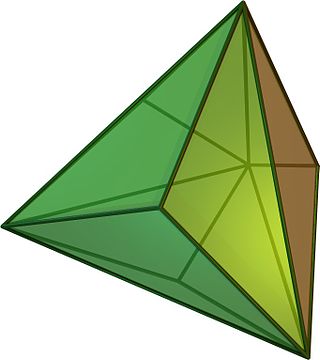Triakis tetrahedron
Catalan solid with 12 faces From Wikipedia, the free encyclopedia
In geometry, a triakis tetrahedron (or tristetrahedron[1], or kistetrahedron[2]) is a solid constructed by attaching four triangular pyramids onto the triangular faces of a regular tetrahedron, a Kleetope of a tetrahedron.[3] This replaces the equilateral triangular faces of the regular tetrahedron with three isosceles triangles at each face, so there are twelve in total; eight vertices and eighteen edges form them.[4] This interpretation is also expressed in the name, triakis, which is used for Kleetopes of polyhedra with triangular faces.[2]
| Triakis tetrahedron | |
|---|---|
 | |
| Type | Catalan solid, Kleetope |
| Faces | 12 |
| Edges | 18 |
| Vertices | 8 |
| Symmetry group | tetrahedral symmetry |
| Dihedral angle (degrees) | 129.52° |
| Dual polyhedron | truncated tetrahedron |
| Properties | convex, face-transitive, Rupert property |
| Net | |
 | |

The triakis tetrahedron is a Catalan solid, the dual polyhedron of a truncated tetrahedron, an Archimedean solid with four hexagonal and four triangular faces, constructed by cutting off the vertices of a regular tetrahedron; it shares the same symmetry of full tetrahedral . Each dihedral angle between triangular faces is .[4] Unlike its dual, the truncated tetrahedron is not vertex-transitive, but rather face-transitive, meaning its solid appearance is unchanged by any transformation like reflecting and rotation between two triangular faces.[5] Whenever a triakis tetrahedron has a hole, it is possible for a polyhedron to exist with the same or larger size passing through it.[6]
A triakis tetrahedron is different from an augmented tetrahedron as latter is obtained by augmenting the four faces of a tetrahedron with four regular tetrahedra (instead of nonuniform triangular pyramids) resulting in an equilateral polyhedron which is a concave deltahedron (whose all faces are congruent equilateral triangles). The convex hull of an augmented tetrahedron is a triakis tetrahedron.[7]
See also
References
External links
Wikiwand - on
Seamless Wikipedia browsing. On steroids.


